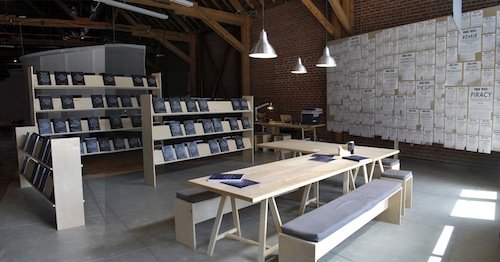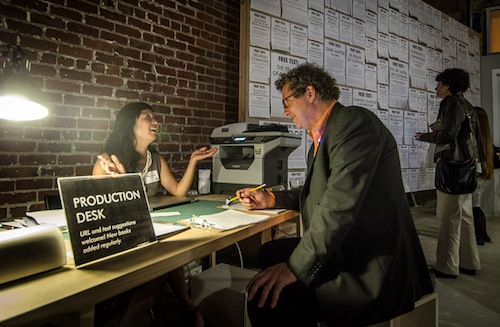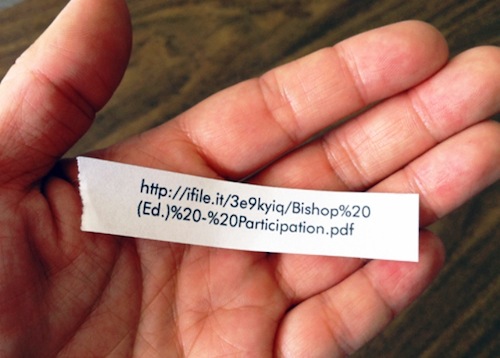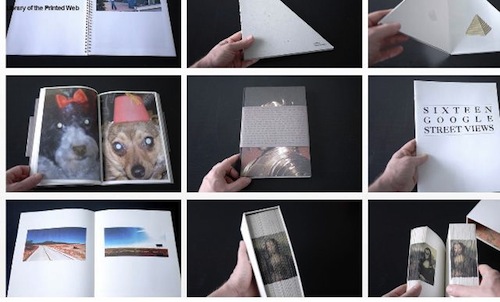
Stephanie Syjuco. “Free Texts: An Open Source Reading Room,” 2012. Commissioned by the ZERO1 Biennial, San Jose, CA. September 12-December 5, 2012.
Much of what we experience on the Internet parallels how the brain functions. Independently working entities connect like a web, a network, an ecosystem. In this vast online space of seemingly global information, the notion of open source forces one to ask what is “open” and “free,” from the dynamic and virtual environments we share down to the numbers and letters we use to communicate. But what happens when free virtual matter manifests in the physical world? How does that material translate in real life? And how should we assign value?

Stephanie Syjuco. “Free Texts: An Open Source Reading Room,” 2012. Commissioned by the ZERO1 Biennial, San Jose, CA. September 12-December 5, 2012.
In 2012, the ZERO1 Biennial commissioned Bay Area-based artist and educator Stephanie Syjuco to create the site-specific installation Free Texts: An Open Source Reading Room—an analog version of an online open source library. The artist herself was part of the installation; she sat at a desk with a lamp, laptop, and HP LaserJet printer. All of this was arranged next to a wall of various sized flyers that mimicked lost pet notices, except the tear-away strips were printed with URL codes instead of a phone number. The words “Free Text” appeared directly above a selection of readymade bound books placed on the table for visitors’ casual perusal; they included art history and critical theory texts such as Free Culture by Lawrence Lessig, and Garrett Hardin’s essay “The Tragedy of the Commons.” For visitors who expressed profound interest in a specific text, Syjuco offered on demand printing and bookbinding.

Stephanie Syjuco. “Free Texts: An Open Source Reading Room” (detail), 2012. Commissioned by the ZERO1 Biennial, San Jose, CA. September 12-December 5, 2012.
Free Texts is about the personal act of acquiring text and, more importantly, knowledge. I am almost certain that, like myself, many Internet users have no issue with downloading texts online, be it legal or illegal. Free Texts serves as commentary on digital culture and consumption. It also raises a point about our ongoing desire for tangible objects. Reading (and writing) on paper fascinates people probably more so now than ever before because it seems almost retro. And yet thumbing through books allows needed respite from the daily practice of swiping screens.
A year after seeing Syjuco’s installation, it resurfaced for me during the conference Theorizing the Web, where artist Paul Soulellis presented his project Library of the Printed Web (2013), his own collection of printed material from the Internet. It happens to include some books from Syjuco’s Free Texts. Soulellis and Syjuco share interest in the meaning of a hard copy in a digitally laden and highly mobile society. If traditional forms of tactility are increasingly absent from the reading experience, what does is mean to print text from the Web? How does information that’s passed different hands and can easily be doctored remain “legitimate”? Is text printed from the Web less or more compelling than text purchased through traditional forms of capitalism or consumed through electronic devices?
Syjuco deliberately omits imagery from Free Texts, asking her audience to engage with dense theoretical texts. Whereas in Soulellis’s Library of the Printed Web, he focuses more on images that have been altered or remixed in virtual spaces. Both artists, by turning virtual matter into printed and packaged objects, create new, analog bodies of work for people to consume. Their works beg close examination of our ongoing desire for physical things when those things can be virtually and easily consumed. And then, even as we download or print what we believe to be free, we acquire these goods through costly devices and the price of a connection. All things considered, nothing is actually free.
Dorothy Santos is Blogger-in-Residence through August 30, 2013.





